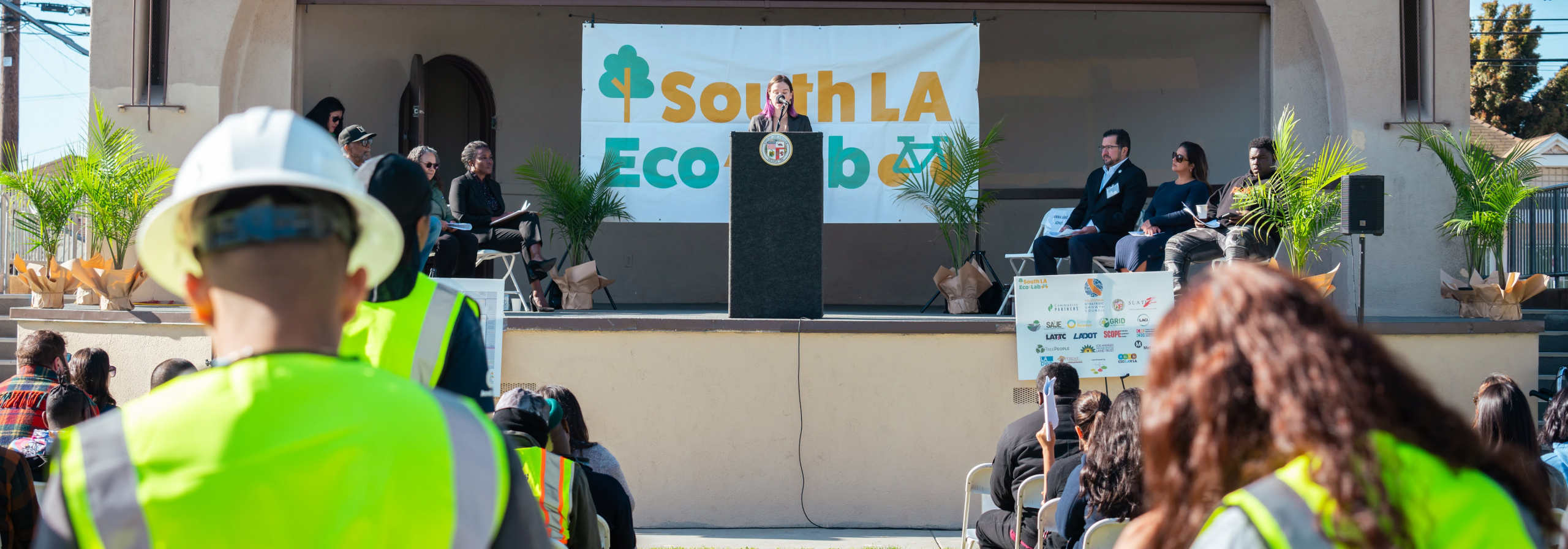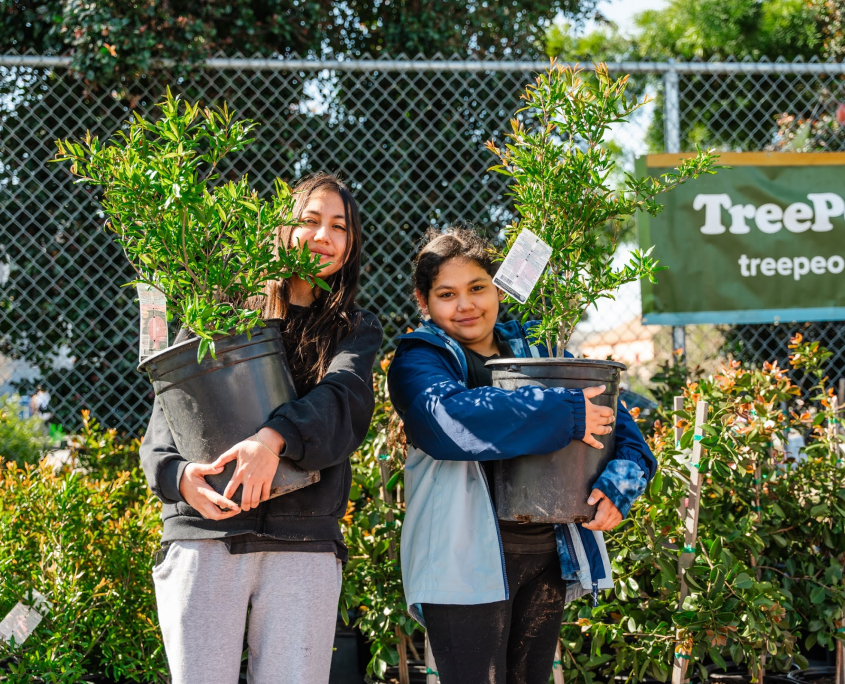ABOUT THE COMMUNITY
The 51-square-mile South LA community, located within the City of LA, is surrounded and bisected by several major freeways, including Interstates 10, 105, and 110. South LA ‘s geographic boundaries have shifted at times to include portions of nearby cities like Commerce and Compton, however, all geographic delineations of South LA depict the majority square-miles entirely within the City of LA. South LA has a complex economic and industrial history and has made significant cultural and civic contributions to Los Angeles.
South LA is one of the most demographically diverse regions in California, with a population of approximately 812,847 residents (2023 Census).
The region’s racial and ethnic makeup includes approximately:
- 67.2% Hispanic
- 2.5% Asian
- 3.8% non-Hispanic White
- 23.6% Black
South LA suffers from higher levels of poverty and unemployment than the rest of the state.
Such inequities are the byproduct of a complex economic history influenced by migration, industry, and systemic disinvestment, such as redlining and racist lending practices. After the LA Uprising in 1992, fueled by police brutality and economic and racial injustices, insurance companies, banks, and investors further exacerbated inequities by lacking interest in South LA’s recovery.
South LA Eco-Lab Project Area
The project area for the South LA Eco-Lab is located in the heart of South LA and covers approximately 3.9 square miles. The project area is bisected by the I-110 freeway and spans the area between two major Los Angeles streets, Central Avenue to the east and Western Avenue to the west.
A Brief History of South LA: The Legacy of Environmental Injustice
Within the City of Los Angeles, South LA is approximately 51 square miles with 812,847 people living in 28 neighborhoods. This section provides more history of South LA, and how environmental injustices from the past still affect the lives of residents today.
From Gabrielino/Tongva Lands to Spanish Mission and Urban Expansion
The Gabrielino/Tangva people are the original inhabitants of the unceded territory of the Los Angeles Basin, including South LA.1 The Gabrielino/Tongva Nation can trace their ancestral connections to this land over 7,000 years.2 The Tongva people are represented in several thousand archaeological sites, confirming their long-standing presence in the territory.3
Spanish colonizers arrived in the late 18th century, establishing the Mission San Gabriel Arcángel in 1771. The Tongva people were forcefully displaced to this mission, where their traditional way of living was disrupted. A decade later, Los Pobladores from Mexico (New Spain) established “El Pueblo de Nuestra Señora la Reina de los Ángeles, (The Town of Our Lady the Queen of the Angels).4
Colonizer disruptions included enslavement of the Tongva people, untenable living conditions, fatal foreign diseases, and significant cultural suppression. Despite these devastating impacts, the Gabrielino/Tongva people continue intentional preservation efforts to this day, including language revitalization programs and environmental conservation projects.5
1 https://gabrielinotongva.org/
2 https://www.southcentralarchive.com/projects/south-central-timeline.com
3 https://www.tongvapeople.org/
4 https://www.southcentralarchive.com/projects/south-central-timeline.com
5 https://gabrielinotongva.org/culture/
Waves of Settlement and Migration
In 1821, Mexico achieved independence, and the region was included in the Rancho La Ballona land grant. The U.S. officially acquired California in 1848 through the Treaty of Guadalupe Hidalgo, ending the Mexican-American War. Quick expansion of the South LA region soon followed with increased settlement of Americans and the establishment of the University of Southern California in 1880.6 The Los Angeles region, and specifically South LA, has a long history of migration for people seeking opportunity and community.
1900s-1920s
European immigrants began to migrate to the greater Los Angeles region seeking employment. South LA was mainly populated with White, working-class families for the first few decades of the 1900s. The South LA area exploded with opportunity through industrial jobs in factories, an expansion of trolley transportation, and an abundance of affordable housing for working-class families. It was one of the few regions where working-class Whites could still afford to purchase homes near their jobs.
1916-1970s
From 1916 to the 1970s, over six million African Americans moved from the rural Southern U.S. to urban areas in Northern states or out West.7 Thousands came to LA in search of jobs and freedom from debt slavery, the oppression of Jim Crow laws, lynchings, and other forms of structural racism. Many communities in LA maintained strict racial covenants and redlining lending practices to restrict African Americans from owning homes. However, South LA was more accessible in the 1920s for the first wave of African American families to settle, buy homes, and become a cornerstone of the community.8 During this time, a mix of cultures birthed a vibrant creative community represented in the burgeoning Jazz music scene on Central Avenue and the beginning construction of the Watts Towers (1921) by Italian immigrant Sam Rodia.
A second wave of African American migration drastically shifted demographics by the 1970s. Fuelled in part by fast- changing demographics and resistance to desegregation policies in the 1940s, mass departures, or “White Flight” of White working-class residents, led South LA to become known as the “Black Belt” of the city.9 Federal policies required an integration of White and Black residents across multiple social dimensions, in particular, the school system. Schools were hit particularly hard as a result of White flight because their withdrawal resulted in a domino effect of lost tax revenue for schools, a decrease in property values, and overall disinvestment in the region. As White families moved out, the now predominantly Black schools experienced disparities in resources and educational outcomes.
Community tensions over long-standing economic inequalities, discriminatory practices, and police brutality came to a head on August 11, 1965, when South LA became the epicenter of six days of violence in the Watts Uprising. Two young Black men, Marquette Frye and his brother, were pulled over by a highway patrol officer in Watts. Marquette was suspected of being intoxicated. His brother ran to their nearby family home and returned with his mother. The family and police officers began to fight. The Los Angeles Police Department escalated the interaction by using batons on the family. A crowd gathered and tensions exploded, fueled by accusations of police brutality and decades of racial and economic injustices. Watts suffered millions of dollars in damage and 34 deaths, among other outcomes. The Watts Uprising sparked national conversations that led to a significant impact on the Civil Rights Movement.
1980s-2000s
From the 1980s through the 2000s, South LA became a predominantly Latino community, shifting from 80% African American in the 1980s to over two-thirds Latino.10 In particular, there was an influx of immigrants fleeing civil wars in El Salvador, Guatemala, and Nicaragua, and immigrants from Mexico seeking economic opportunities and safety from organized crime. This shift was possible by the simultaneous exodus of African Americans from South LA to the Inland Empire and North LA County. Black families were looking for economic opportunity and to escape the disinvestment and rising crime of LA.11
6 ibid.
7 https://www.britannica.com/event/Great-Migration
8 https://www.southcentralarchive.com/projects/south-central-timeline
9 https://lasouthconnections.com/the-historical-significance-of-south-los-angeles/
10 https://today.usc.edu/lessons-from-the-transformation-of-south-los-angeles
11 https://www.southcentralarchive.com/projects/south-central-timeline
Discriminatory Lending and Investment Practices
Discriminatory housing policies like redlining and restrictive covenants forced people of color to reside in specific areas throughout LA, most often near hazardous industrial zones. South LA had historically been a region for expansive industrial opportunity, resulting in several rubber and automotive factories. The African American and immigrant populations in South LA often lacked the civic power to influence zoning for industrial development, nor advocate for safer and healthier conditions for residents.12 Despite factory closures, the communities in South LA continue to struggle with the environmentally hazardous conditions left by years of discriminatory industrial development.
Predatory subprime lending practices hit South LA particularly hard between 2004 and 2008. Subprime lending is the practice of lending to borrowers who do not meet typical “prime” loan requirements due to poor credit, high debt-to-income levels, and low income. Subprime lending to low-income communities, like parts of South LA, was a targeted practice.13 Many low-income borrowers were given mortgages that they could not pay, resulting in a foreclosure crisis that disproportionately impacted African American and Latino borrowers. Mass defaults and foreclosures hurt property values for most communities, but the impact in an already disadvantaged community like South LA set off a domino effect of abandoned properties, rising crime rates, and further disinvestment.
12 Ibid.
13 https://labusinessjournal.com/news/subprime-loans-concentrated-in-low-income-areas
Discriminatory Zoning and Environmental Injustice
Redlining and zoning laws that allowed freeway construction and hazardous facilities to operate near homes and schools contributed to disinvestment in South LA.14 The region faces long-term environmental public health consequences as a result of being a “sacrifice zone” where communities of color have been exposed to several environmental hazards.15
The long-term health outcomes and incidence of chronic conditions for South LA residents are significantly higher than the rest of the city.16 The cumulative industrial emissions of dangerous pollutants contribute to poor air quality as well as higher rates of asthma and heart disease among other health disparities.17 Discriminatory zoning designations have also created higher temperatures and increased risk for heat-related health conditions as a result of limited green spaces, trees, and vegetation.
14 https://www.pbssocal.org/shows/departures/land-use-in-south-l-a-a-legacy-of-environmental-crime
15 https://today.usc.edu/sacrifice-zone-los-angeles-true-cost-of-industrialization-on-public-health
16 https://www.psr-la.org/stay-informed/blog/scla-push-ab-617
17 https://www.pbssocal.org/neighborhood-data-for-social-change/the-most-pressing-environmental-health-conditions-for-latinx-communities-in-southeast-l-a
Community Resistance and Policy Reform
Despite the legacy of economic and environmental discriminatory practices, the community of South LA has a rich history of resident advocates and activists pushing for positive change. Grassroots organizations have led the charge advocating for systemic change in environmental policies and equitable economic development. Seeds of community resilience and resistance have been planted across several sectors, and reinvestment in South LA is returning, encouraging new development.
Organizations like the California Environmental Justice Alliance (CEJA), Esperanza Community Housing Corporation, Strategic Actions for a Just Economy (SAJE, a TCC project partner), STAND-LA, Better Watts Initiative, and several others have led initiatives to address environmental injustices with data-informed policy changes.18 The organizations have been successful in contributing to institutional reforms, such as the passage of Senate Bill 1137 (2022), which creates health protection zones that restrict and closely monitor oil and gas operations throughout the state, including South LA.19 Additionally, the community successfully advocated for policies like the LA County “Green Zones Sensitive Use Buffers” that was implemented in 2022, which restricts industrial activities within 500 feet of sensitive areas such as residences, schools, parks, and daycares.20 In addition to these policy wins, community members and organizations continue advocating for the rejection of damaging environmental policies.21
With renewed focus and interest in the South LA area, equitable economic advancement for longtime residents and businesses remains a priority. Gentrification and rising rents in reinvested areas have spurred a new migration pattern in the displacement of longtime residents and business owners of color. However, the continued collaboration of South LA residents and grassroots organizations is working to address this. The community of South LA has shown its commitment to an equitable and sustainable future for South LA residents by advocating for policies that support systemic changes to correct the environmental and economic injustices of the past.
18 https://ceja.org/what-we-do/green-zones/south-central-los-angeles-the-500-feet-project
19 https://www.conservation.ca.gov/calgem/Pages/SB1137.aspx
20 https://planning.lacounty.gov/long-range-planning/green-zones-program/
21 https://apnews.com/article/hazardous-waste-toxic-soil-ee14f94fd8c0b2dea5ea2a941560142c
Local leaders win a $35 million TCC grant to address persistent inequities in South Los Angeles.
Top page photo:
South LA’s Earth Day Kick-Off 2024
Credit: Irina Beffa



